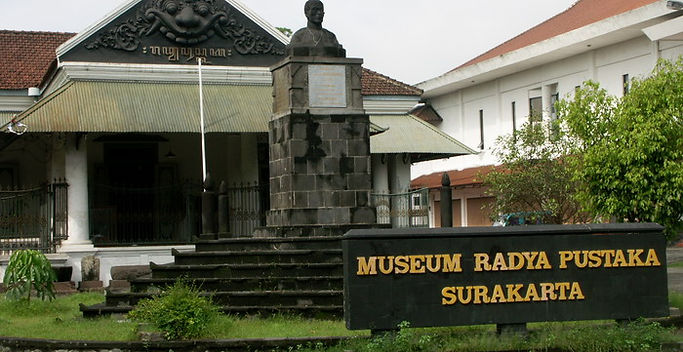top of page

Surakarta Palace
Surakarta Palace built by Pakoe Boewono II in 1744 AD . Formerly the capital of the palace is in Kartasura, which is approximately 12 km on the west of Solo. Surakarta Palace contained Art Gallery which stores a variety of historical objects that have historical value and high art. Some existing collections such as heritage carriage, an assortment of weapons, shadow puppets and objects other relic. Surakarta Palace open to the public every day at 8.30 am to 2 pm and Sunday at 8.30am to 1 pm. It closed on Friday .
Physically Surakarta palace building consists of the main building and supporting environments such as Gapura ( gate ) called Gladag to the south. Then there are two square to the north and south of the palace complex . There is also the Grand Mosque and the famous Batik market,i.e. Klewer Market. Kyai Slamet, sacred white buffalo as one of the Surakarta Palace heritage.

Pura Mangkunegaran
Pura Mangkunegaran was built in 1757 by Raden Mas Said, better known as Prince Sambar Nyawa, after signing Salatiga Agrrement on March 13th. Raden Mas Said later became Prince Mangkoenagoro I. Mangkunegaran Palace consists of two main parts: pendowo (the pavilion) and dalem(the huse) that is flanked by the palace residence of the royal family. The interesting thing is the whole palace was made of round teak wood/Utub.
Pendopo is Joglo with four pillars ( main mast ) which is used for receptions and traditional Javanese dance performances. There is a set of gamelan named Kyai Kanyut Mesem. Gamelan wich is a large part of this complete still played on certain days to accompany traditional dance training. In the palace there Pringgitan, the space where the family receives officials. This room is also used to perform puppet. In the pringitan, there are several paintings by Basuki Abdullah, famous painter from Solo.
Dalem is also used to display various collections of valuable relics of artistic and high historical. There is a collection of traditional masks from various regions in Indonesia , ancient books from Majapahit and Mataram, a collection of a variety of gold jewelery and some collection of the portraits of Mangkunegoro.
Mangkunegaran also has a library called Rekso Pustoko. Collection of traditional masks from various regions in Indonesia, such as Solo, Yogyakarta, Cirebon, Madura and Bali. Also some collection of masks from China.
Visitors can obtain a wide range of gift and souvenir at Pare Anom art. Mangkunegaran open to the public every day at 9 am to 2 pm, Friday 9 am to 12 pm, Sunday at 9am to 2 p.m. There are also several collections of trains are used for traditional ceremonies.

Radya Pustaka Museum
Established in 1890 by Kanjeng Adipati Sosriningrat IV during the governorship of Pakubuwono IX on October 28, 1890, Radya Pustaka Museum is the second oldest museum in Indonesia (the oldest being the National Museum of Indonesia in Jakarta). The museum kept various literature in Old Javanese and Dutch languages. The museum is located within the park complex of Taman Sriwedari.On January 1, 1913, the museum was moved to its present location, formerly the residence of a Dutchman Johannes Busselaar.
A bust of Rangga Warsita, a 19th-century poet of the Surakarta Kraton, is placed on the front yard of the museum. The statue was inaugurated in 1953 by - at that time - the Indonesian president Sukarno.
Several 17th and 18th-century Dutch East India Company's cannons are kept in the museum, as well as smaller cannons of the Kraton. There is also Hindu-Buddhist sculptures discovered around Surakarta, wayang puppets, wayang beber, ceramic, gamelan set, and Javanese kris.
bottom of page
